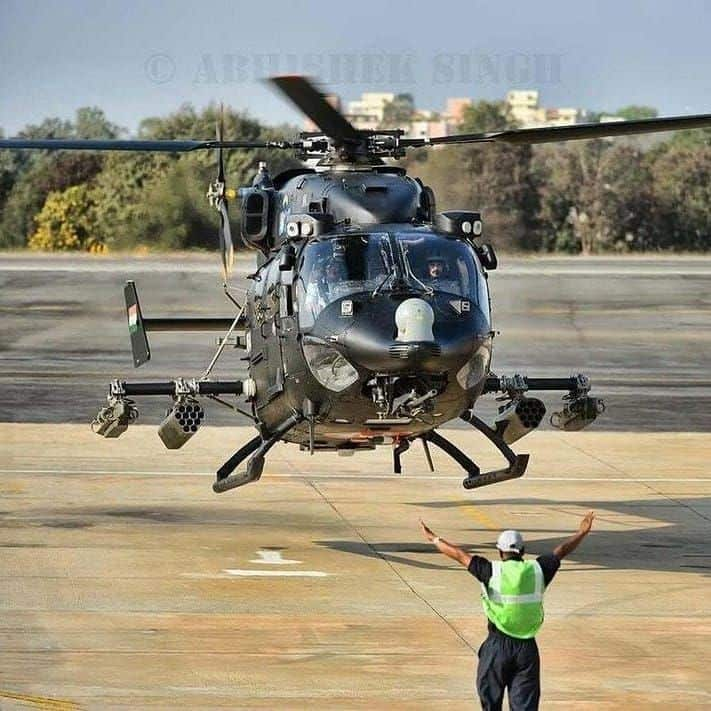synopsis
HAL has been the bedrock of India's aerospace ambitions, a legacy etched in the design, development, and production of cutting-edge aircraft and helicopters for the nation's defense forces.
For over eight decades, Hindustan Aeronautics Limited (HAL) has been the bedrock of India's aerospace ambitions, a legacy etched in the design, development, and production of cutting-edge aircraft and helicopters for the nation's defense forces. Far from fading into the background, HAL is experiencing a powerful resurgence, propelled by a swelling order book, strategic collaborations, and its central role in India's "Make in India" and "Atmanirbhar Bharat" initiatives. The anticipated orders for Prachand Light Combat Helicopters (LCH), the ongoing production of Tejas Light Combat Aircraft (LCA), and the continued evolution of Advanced Light Helicopter (ALH) variants underscore HAL’s enduring leadership and its indispensable contributions to national security and economic progress.
The notion that HAL is being relegated to a mere assembly role fundamentally misunderstands its profound legacy and its continuous drive for indigenous defense innovation. HAL's comprehensive expertise, from initial design to final delivery, is vividly demonstrated by the Tejas LCA, a formidable 4.5-generation fighter, and the Prachand LCH, uniquely capable of operating at extreme altitudes like the Siachen Glacier. While a firm order for 156 Prachand helicopters is keenly anticipated, the ongoing production and deliveries solidify HAL's position as a primary manufacturer of advanced rotorcraft. Furthermore, the significant order for 97 Tejas Mk1A aircraft, alongside the expected LCH contracts, highlights its dominance in fixed-wing platforms. These commitments, coupled with HAL's delivery of the first LCA twin-seater trainer to the Indian Air Force in 2023, showcase its end-to-end capabilities.

The narrative of HAL’s diminishing significance also overlooks its strategic adaptation within a growing collaborative defense ecosystem. While private sector players like Tata and L&T contribute to projects such as the C-295 transport aircraft, HAL remains an indispensable partner, supplying critical components and leveraging its deep integration expertise. HAL’s partnerships with global Original Equipment Manufacturers (OEMs), including Safran for the ALH’s Shakti engine and GE for the Tejas Mk2’s F414 engine, facilitate crucial technology transfer and the localization of production, directly supporting India's self-reliance objectives.
HAL’s robust order book, which had already reached approximately ₹1.3 lakh crore by late 2024 and surged to around ₹2.2 lakh crore in early 2025, encompassing 240 AL-31FP engines for Su-30 MKI and 12 additional Su-30 aircraft, underscores its continued relevance in both indigenous and licensed manufacturing. Rather than being sidelined, HAL serves as a vital linchpin in public-private synergies, ensuring India’s defense capabilities are both innovative and scalable.
Critics who point to HAL’s past delivery delays and quality concerns, such as the ALH Dhruv's grounding incidents, often fail to recognize the company’s proactive responses and inherent operational resilience. HAL addressed the ALH's swashplate fracture issue through fleet grounding and comprehensive upgrades, with phased safety enhancements underway to restore full operational readiness. The company’s unwavering commitment to quality is further evidenced by its plan to commence deliveries of the 11 Tejas Mk1A aircraft by the end of 2025, navigating engine supply challenges through strategic reserves and GE’s renewed commitments. Moreover, HAL is actively expanding its production capacity, with ambitious plans to increase helicopter output from 30 to 90 units annually and Tejas production to 24 aircraft per year, ensuring timely fulfillment of both domestic and potential export orders.
The rise of private sector players in the defense arena should be viewed as a complementary force, enriching the ecosystem rather than threatening HAL’s established dominance. HAL’s status as a Public Sector Undertaking (PSU) ensures cost-effective production, channeling revenues back into public funds, a distinct advantage over private firms driven by profit margins. For instance, HAL’s ability to produce the Tejas at a competitive cost compared to imported alternatives has made it a cornerstone of the Indian Air Force’s modernization plans, with 180 Mk1A units envisioned.
HAL’s export potential is also gaining significant traction, with Nigeria poised to become the first international customer for four Prachand helicopters and strong interest from the Philippines and Argentina for both the Tejas and ALH platforms. HAL’s expanding global footprint, with offices in Malaysia, the UK, and Egypt, strategically positions it to capture a substantial share of India’s ambitious $5 billion defense export target.
Concerns regarding HAL’s potential loss of institutional knowledge are unfounded, given its substantial workforce of over 28,000 skilled professionals and its 11 dedicated Research and Development (R&D) centers spearheading crucial projects like the Advanced Medium Combat Aircraft (AMCA) and the Indian Multi-Role Helicopter (IMRH). HAL’s leadership in developing indigenous critical systems, such as the HTSE-1200 engine for the Prachand and ALH, guarantees long-term self-reliance in key technological domains.
Unlike private firms that often rely on foreign OEMs, HAL’s government oversight ensures strategic autonomy, effectively mitigating the risks associated with international supply chain vulnerabilities. Furthermore, HAL’s extensive Maintenance, Repair, and Overhaul (MRO) infrastructure continues to provide vital support for legacy platforms like the Su-30 and MiG-29, ensuring sustained operational readiness across the Indian Air Force, Army, and Navy.
The argument that increased private sector involvement inevitably leads to inflated costs is effectively countered by HAL’s proven cost-effective model, which consistently delivers high-value defense platforms at competitive prices. The anticipated ₹62,700 crore Prachand deal and the significant Tejas orders are executed under stringent government oversight, ensuring affordability and fiscal responsibility.
HAL’s financial health remains robust, evidenced by its record revenue of ₹29,810 crore in the fiscal year 2023-24 and an order book projected to reach an impressive ₹2.2 lakh crore by 2030. In contrast, while private sector projects like the C-295 are valuable additions, they often involve higher costs due to foreign collaborations, further validating HAL’s crucial role as a cost-efficient backbone of India’s defense ecosystem.
Far from being diminished, HAL is strategically positioned to spearhead India’s aerospace ambitions through a balanced and forward-looking approach:
Sustained R&D Leadership: HAL is actively fast-tracking the development of the AMCA and IMRH, with the eagerly anticipated first flight of the Tejas Mk2 slated for 2025, reinforcing its strong legacy of indigenous innovation.
Strategic Public-Private Synergy: HAL is actively collaborating with private sector partners like L&T for the production of Tejas fuselages, optimizing production efficiency while retaining crucial design control and intellectual property.
Commitment to Cost Efficiency: HAL’s PSU model inherently ensures competitive pricing, with rigorous mechanisms such as competitive bidding processes maintaining strong fiscal discipline across its operations.
Growing Global Ambition: HAL’s proactive export initiatives, including the potential Prachand sales to Nigeria and ongoing Tejas discussions with the Philippines, directly align with India’s national $5 billion defense export target.
Continuous Operational Modernization: Significant investments in advanced automation technologies and comprehensive workforce training programs are enhancing HAL’s overall efficiency, ensuring it can effectively meet the growing demands of both domestic and international customers.
HAL's journey is one of enduring resilience and continuous ascendancy, powerfully underscored by its pivotal role in delivering critical platforms like the Prachand, Tejas, and various ALH variants. With a robust and expanding order book, strategic and mutually beneficial partnerships, and an unwavering commitment to the principles of self-reliance, HAL remains India’s preeminent aerospace vanguard, driving national security and fostering economic prosperity for the nation's future.
(The author Girish Linganna of this article is an award-winning Science Writer and a Defence, Aerospace & Political Analyst based in Bengaluru. He is also Director of ADD Engineering Components, India, Pvt. Ltd, a subsidiary of ADD Engineering GmbH, Germany. You can reach him at: girishlinganna@gmail.com)
;Resize=(690,390))
 subscribe to Asianet News Whatsapp channel by clicking here.
subscribe to Asianet News Whatsapp channel by clicking here.